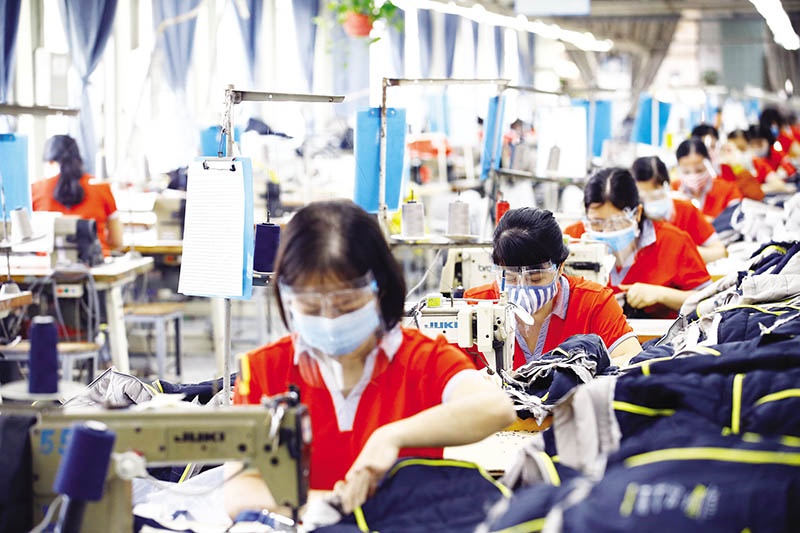Vietnam's economy begins rebound from COVID-19 Delta wave
 |
| Vietnam is looking at much-improved growth prospects in 2022 |
In 2020, Vietnam was one of the most resilient economies in the Asia-Pacific region to the shockwaves from the global COVID-19 pandemic, with very low numbers of COVID-19 cases throughout most of 2020. Economic growth was strong in the first half of 2021, with GDP in the second quarter of 2021 rising 6.6 per cent on-year. However, a severe COVID-19 Delta wave engulfed the nation in mid-2021, resulting in a sharp contraction in GDP growth in the third quarter of 2021.
The latest economic data for the fourth quarter of 2021 compiled by IHS Markit Vietnam are showing signs of recovering economic momentum after the latest COVID-19 Delta wave. Overall, the pace of Vietnam's economic growth is expected to moderate to 2.3 per cent in 2021, compared with the 2.9 per cent growth rate recorded in 2020.
However, a key uncertainty in the near-term outlook is the extent and duration of the current wave of new COVID-19 cases that is hitting the nation. If daily new COVID-19 cases rise sharply again, this would pose a significant further risk to the near-term outlook for domestic demand. There would also be the added risk of renewed protracted disruption to manufacturing output if widespread COVID-19 clusters are again detected in major manufacturing facilities or logistics supply chains, as occurred in July and August. Furthermore, unless Vietnam can significantly ramp up its fully vaccinated rate in coming months, it remains vulnerable to new COVID-19 outbreaks.
Despite these near-term risks, over the medium-term economic outlook, a large number of positive growth drivers are creating favourable tailwinds and will continue to underpin the rapid growth of Vietnam's economy. This is expected to drive strong growth in Vietnam's total GDP as well as per capita GDP.
Vietnam's total GDP is forecast to increase from $270 billion in 2020 to $433 billion by 2025, rising to $687 billion by 2030. This translates to very rapid growth in Vietnam's per capita GDP, from $2,785 per year in 2020 to $4,280 per year by 2025 and $6,600 by 2030, resulting in substantial expansion in the size of Vietnam's domestic consumer market.
Vietnam's role as a low-cost manufacturing hub is also expected to continue to grow strongly, helped by the further expansion of existing major industry sectors, notably textiles and electronics, as well as the development of new industry sectors such as automobiles and petrochemicals.
For many multinationals worldwide, significant supply chain vulnerabilities have been exposed by the protracted disruption of industrial production in China as well as some other major global manufacturing hubs during the COVID-19 lockdowns. This will drive the further reshaping of manufacturing supply chains over the medium term as firms try to reduce their vulnerability to such extreme supply chain disruptions.
With US-China trade and technology tensions still remaining high, this is likely to be a further driver for the reconfiguring of supply chains. A key beneficiary of the shift in global manufacturing supply chains will be the ASEAN region, with Vietnam expected to be one of the main winners.
What the stars mean:
★ Poor ★ ★ Promising ★★★ Good ★★★★ Very good ★★★★★ Exceptional
Related Contents
Latest News
More News
- PM orders investment model for North–South high-speed rail (December 22, 2025 | 17:43)
- First members of Danang International Finance Centre revealed (December 22, 2025 | 17:39)
- Securing capital and efficiency for Vietnam’s 2026-2030 growth ambitions (December 17, 2025 | 10:00)
- Driving double-digit growth through green and circular transformation in Vietnam (December 17, 2025 | 09:00)
- Vietnam bucking trend in the global M&A landscape (December 16, 2025 | 14:20)
- Vietnam’s green transition demands collective financial action (December 15, 2025 | 12:00)
- VIR workshop highlights capital and policy for sustainable development (December 15, 2025 | 11:00)
- National Assembly approves pilot mechanisms to accelerate major projects in Hanoi (December 12, 2025 | 11:29)
- Vietnam eases policy approval requirements, simplifies foreign and outbound investments (December 11, 2025 | 17:53)
- Unpacking new momentum in Vietnam’s M&A market (December 10, 2025 | 09:59)

 Tag:
Tag:




















 Mobile Version
Mobile Version